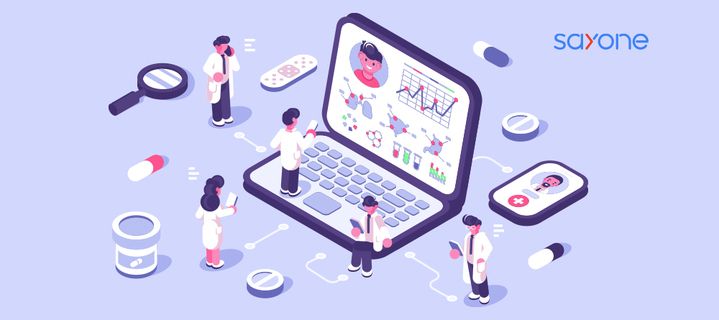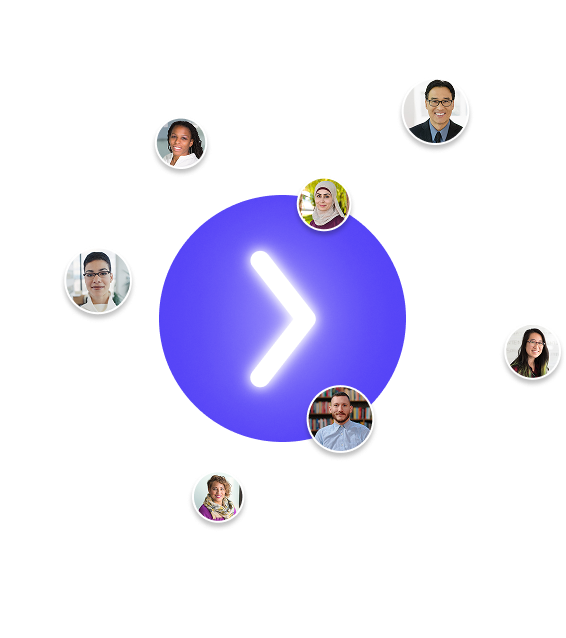
Subscribe to our Blog
We're committed to your privacy. SayOne uses the information you provide to us to contact you about our relevant content, products, and services. check out our privacy policy.

Jomin Johnson April 28, 202316 min read

Generating table of contents...
As technology advances, so does the healthcare industry. Healthcare software development has become increasingly important in recent years as the healthcare industry continues to evolve and face new challenges. From electronic health records to telemedicine platforms, healthcare software has the potential to revolutionize the way we receive and provide healthcare services. This guide will provide an overview of the healthcare industry and its challenges, explore the advantages of custom healthcare software development, and delve into the medical software development process.

1. Adherence to Regulations: Healthcare software needs to abide by a number of rules and regulations, including GDPR in Europe and HIPAA in the United States. The privacy and security of patient data are guaranteed by these laws.
2. Privacy and Security of Data: It is crucial to protect patient data's privacy and security. Strong security measures must be used in healthcare software to guard against cyberattacks and data leaks.
3. Cooperation: Information must be used and exchanged between healthcare systems with ease. Different standards and protocols are used across different systems, which presents interoperability issues.
4. The Experience of the User: Software for healthcare must be easy to use for patients and healthcare providers alike. An interface that is difficult to use or understand could make it less effective.
5. Agility: Healthcare companies need to expand their software systems to accommodate more data and users without sacrificing efficiency as they develop.
6. System Integration with Current Systems: Compatibility concerns make integrating new software with old systems difficult. Maintaining effective workflows depends on ensuring smooth integration.
The healthcare industry is a complex system that involves a wide range of services and professionals dedicated to improving the health and well-being of individuals. The industry faces numerous challenges, including an ageing population, rising healthcare costs, and a shortage of healthcare professionals.
Healthcare organizations are turning to technology and custom software development to address these challenges. This involves creating tailored software solutions to meet the specific needs of healthcare professionals and patients. Healthcare software is transforming healthcare delivery from electronic health records to telemedicine platforms.
Read our blog: How Prescriptive Analytics is benefiting Healthcare industry
As the industry continues to evolve, software development will play an increasingly important role in improving the quality and accessibility of healthcare services.

Developing software customized for the healthcare industry offers numerous advantages over off-the-shelf solutions. Here are some of the key benefits:
The number of healthcare apps available on the Play Store and App Store combined is currently over 95,000, and it is constantly growing. Therefore, you should be aware of the various kinds that are on the market if you intend to develop a healthcare website or app. Determine your wants and desires for customisation after familiarising yourself with the features and classifications of current healthcare projects.
Software for patients or general users and software for healthcare professionals are the two categories into which healthcare software belongs.
Let's talk about each in more detail.
This should be quite obvious. These days, you can create software of this kind to greatly simplify the lives of users or patients. These gorgeously made apps are straightforward but quite helpful, serving a variety of functions and advantages like:
1. Software for Health Monitoring
Health monitoring apps are one of the best instances of healthcare software application, as they can be used for anything from symptom assessment to prescribing medication. With the use of this program, patients with long-term medical disorders (such as diabetes, cancer, or cardiovascular diseases) can also maintain their health and take the required precautions.
2. Software for Monitoring Medication
Recently, medical software developers have seen a significant increase in the use of medication tracking apps. These apps can assist patients in tracking nearby pharmacies, the deals those stores are running, and other things in addition to conveniently scheduling and reminding them to take their medications.
3. Software for Mental Health
Businesses now have a fantastic opportunity to support consumers in taking care of their mental health thanks to this type of software. Numerous services, including gamification features, breathing exercises, pre-recorded meditations, and more, are included in mental health software to assist users deal with anxiety, depression, stress, sleeping difficulties, and other issues.
4. Software for Medical Education
Make a medical education app if you wish to provide your consumers with a real, reliable database that contains the most recent medical knowledge. These applications are a great resource for everyone interested in learning more about healthcare, from normal users to doctors and students.
5. Software for a Healthier Lifestyle
This category of software includes a wide range of app features, such as applications for therapy, brain training, and exercise, fitness, and wellbeing, etc. You can live a healthier lifestyle with the aid of all these advantages.
6. Software for Dieting
One excellent example of specialized medical software development is found in diet apps. With the help of tools like meal planning, calorie calculations, reminders, health and food-related information, and more, users may create a diet plan and adhere to healthy eating habits.
Selecting the best automation testing tools requires careful consideration of several factors to ensure the tool aligns with your project’s unique requirements. Here are key factors to guide your decision:
Project Needs: Assess your project’s scope, including the type of application (web, mobile, desktop) and the specific testing needs (functional, performance, security).
User-Friendliness: The tool should have an easy-to-use interface, minimizing the learning curve for your team.
Platform and Language Support: Confirm that the tool is compatible with the platforms (Windows, macOS, Linux) and programming languages (Java, Python, JavaScript) your project uses.
Integration: Ensure the tool can seamlessly integrate with your existing CI/CD pipeline, version control systems, and other development tools.
Scalability: Opt for a tool that can meet your current requirements and scale with your project as it grows.
Cost Consideration: Evaluate the budget for your project, weighing the benefits of open-source versus commercial tools based on their cost-effectiveness.
Adding value and streamlining the healthcare process for physicians, nurses, and other medical staff members is the main objective of these medical software applications. This category offers cutting-edge features for a variety of uses, thanks to healthcare IT services and ever-improving technologies. These features include:
1. Software for Monitoring Patients
By 2025, 90% of hospitals will employ AI-powered technology for remote patient monitoring and early diagnosis. Apps for patient monitoring assist medical professionals in effectively treating patients by allowing them to regularly track their health. Doctors will always have access to test reports and other documentation that patients save on the app.
2. Software for Medical Networking
Even though doctors are sometimes extremely busy and don't seem to have much time for social media, they undoubtedly need a platform to communicate with one another, share knowledge, and hone their decision-making abilities. Some of the most well-known examples of healthcare bespoke software development in this context are medical networking apps.
3. Online medical services
With the use of telehealth services, doctors can make patient appointments and provide consultations via brief conversations or video calls.
There are several benefits to using telehealth services for both patients and healthcare professionals. These apps are quite helpful since they allow patients to consult doctors from the comfort of their couch and reduce the "no shows" rate by 50%.
4. Software for Health Records
Medical professionals can easily and conveniently gather and manage patients' electronic health records, including vital signs (weight, temperature, blood pressure, etc.), appointments, medications, tests, and medical histories, with the use of medical or health record applications. It is extremely important for doctors to have access to such real-time information in order to closely monitor the entire therapy process.
5. Software for E- Prescriptions
From the point of care, doctors and other healthcare professionals can share electronic prescriptions with pharmacies and labs directly by using e-prescription apps to create and submit prescription orders. By adding such features to a pharmacy management system, the accuracy benefits and patient safety that are the focus of today's cutting-edge healthcare software development services are increased.
6. Software for Hospital Management
This kind of software simplifies the entire billing and management procedure. You can maximise employee productivity and achieve the intended result by digitising various processes, such as insurance assignment, payment processing, claims management, patient information, account and administrative work, etc.Additionally, mental health clinics can benefit from specialized solutions that streamline mental health clinic management by automating scheduling, patient records, and virtual care coordination.
Technological breakthroughs and the increasing need for patient-centered, cost-effective treatment are driving a major revolution in the healthcare sector. As 2024 approaches, a number of significant developments in medical software development are reshaping the healthcare industry. These improvements should improve patient outcomes, operational efficiency, and the quality of healthcare provided overall. Now let's examine the top seven trends in medical software development for the year 2024.
Healthcare sector is changing as a result of telemedicine and telehealth, which increase convenience and accessibility to medical treatments. Through gadgets and mobile apps, telemedicine offers remote clinical services such virtual consultations, diagnosis, treatment, and monitoring via telecommunications technology. In addition to telemedicine, telehealth also includes non-clinical activities that improve patient involvement and overall healthcare delivery, such as physician training, administrative meetings, and continuing medical education.
Major Advances:
Trend Overview: The powerful data analytics, predictive modelling, and automation that AI and ML are bringing to medical software is revolutionising the field. These technological advancements are facilitating better decision-making, streamlining processes, and enhancing patient care for healthcare providers.
MajorAdvances:
Overview of Trends: EHR systems are essential to contemporary healthcare, and they are becoming more secure, interoperable, and easy to use with each passing day. The main goals of EHR software updates are to increase data usability and accessibility.
Major Advances:
The Internet of Medical Things (IoMT) is a network of interconnected medical apps and devices that gathers and shares health data. Innovations in patient involvement, chronic illness management, and remote monitoring are being fueled by this trend.
Major Advances:
By providing scalable, adaptable, and affordable options for data processing, management, and storing, cloud computing is revolutionising the healthcare industry. Platforms that are hosted in the cloud are improving efficiency, data sharing, and teamwork.
Major Advances:
Trend Overview: The delivery of healthcare, patient care, and medical education are all seeing major advancements because to VR and AR technologies. Both patient outcomes and medical education are being improved by these immersive technology.
Major Advances:
The process of developing medical software can be complex and requires careful planning and execution to ensure that the resulting product meets the needs of healthcare professionals and patients. Here are some critical steps in the medical software development process:
Requirements Gathering:
The first step in developing medical software is to identify and gather the requirements for the software. This involves conducting interviews or surveys with healthcare professionals, patients, and other stakeholders to ensure the software meets their needs. Developers may also perform market research to identify existing software solutions and potential competitors. This process is crucial for ensuring that the software is tailored to its users' needs and will effectively improve healthcare outcomes.
Read our blog: Healthcare Mobile App Development Trends: Why, How, and How Much
Design:
In this phase, developers create detailed plans for the software's architecture, user interface, and functionality. This involves creating wireframes, mockups, and other design documents to visualize the software's design and ensure it meets the requirements from the previous phase. Developers may use various design tools to create a user-friendly and intuitive interface and ensure that the software's functionality aligns with its intended purpose.
Development:
Once the planning and design phase is completed, the development phase begins. This is where the actual coding of the software takes place. The developers use various programming languages and tools to write the code, create databases, and build the user interface. The development team works closely with the project manager to ensure the software is built according to the specifications outlined in the planning phase. Regular testing and debugging are also conducted during this phase to identify and fix any errors in the code. Once the development phase is completed, the software is ready for deployment.
Testing:
Testing is a critical phase of the medical software development process. Developers use automated testing tools to check for bugs and errors in the code and manual testing by healthcare professionals and patients to ensure that the software functions correctly and meets their needs. This process involves multiple rounds of testing to identify and fix bugs or errors and ensure the software is reliable and effective.
Read our blog: Applications of data analytics in healthcare industry
Deployment:
Once the software is thoroughly tested and approved, it is installed and configured by healthcare organizations. Developers may train users to ensure they are comfortable with the software and can use it effectively. This phase also involves monitoring the software to ensure it works correctly and any issues are addressed quickly.
Maintenance:
After deployment, the software requires ongoing maintenance and updates to ensure that it continues to function effectively and meet the changing needs of the healthcare industry. Developers release updates to address security vulnerabilities, add new features, or fix bugs and errors. This phase also involves monitoring the software to ensure it functions correctly and addresses any issues quickly.
Download and read our ebook for free: Global Software Development Rates: An Overview
The medical software development process is complex and involves multiple phases to ensure that the software meets its users' needs and effectively improves healthcare outcomes.
Outsourcing custom healthcare software development can bring a range of benefits to healthcare organizations. By delegating the task to external software development teams, healthcare organizations can access a wider pool of talent and tap into the expertise of developers worldwide. This can be particularly beneficial when seeking specialized knowledge available elsewhere.
This approach can also be a cost-effective way to develop custom software, as labor costs may be lower in other countries. Additionally, it can provide faster time to market by leveraging the experience and expertise of the external teams.
Outsourcing can also reduce the risk of software development projects failing or going over budget, as experienced service providers have established project management processes and procedures.
Read our blog: The Role of IoT in Mobile App Development
It can also provide greater flexibility and scalability for healthcare organizations, allowing them to adjust software development projects based on changing needs and priorities.
Delegating custom healthcare software development can be a smart choice for organizations looking to develop high-quality software cost-effectively and timely. It provides access to a broader talent pool, cost savings, faster time to market, reduced risk, and greater scalability.
Healthcare software development is crucial in improving patient care and streamlining medical processes. Custom software development offers several advantages over off-the-shelf solutions, and outsourcing can be cost-effective. Remote hiring is becoming more popular, and SayOne offers dedicated healthcare software developers.
Keeping up with healthcare software trends is vital to stay competitive. Healthcare organizations can build effective software solutions that meet their specific needs by following the tips outlined in this guide.

We're committed to your privacy. SayOne uses the information you provide to us to contact you about our relevant content, products, and services. check out our privacy policy.

About Author
Head of AI-Retail @ SayOne Technologies|Project Manager | Product Owner - CSPO®| Lead Business Analyst

We collaborate with visionary leaders on projects that focus on quality